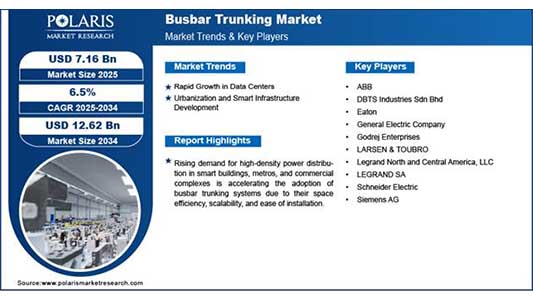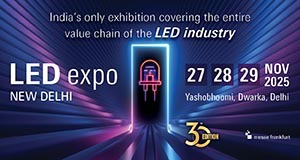Busbar trunking has become increasingly important in modern power distribution systems. The growing need for reliable and safe distribution of energy drives its use. Busbar trunking systems are flexible and carry a compact design as compared to traditional cable-based distribution. With rising urbanization and growing infrastructure projects, the demand for these systems is on the rise. Continue reading as we explore the basics of busbar trunking and detail the key metrics of the busbar trunking market.
What is Busbar Trunking?
Busbar trunking is an alternative method for the distribution of electric power. It makes use of busbars that are enclosed within protective casings instead of conventional cabling. The modular nature of these systems makes their installation easier. Their use is common in high-rise buildings and data centers. They are also used in transport infrastructure, where space and efficiency are highly important.
What Are the Types of Busbar Trunking Systems?
There are various types of busbar trunking systems. The categorization of these systems is largely based on their design and insulation. Below, we’ve explained these types in detail:
Air-Insulated Busbar Trunking
This busbar trunking system type makes the use of air as the primary insulation between the conductors. The system is known for being cost-effective and lightweight. Also, its simple installation makes it suitable for low to medium-power distribution in buildings and complexes. The reliance on air means the system needs more physical space than other types.
Sandwich-Type Busbar Trunking
This system has conductors tightly encapsulated in insulation material. This design minimizes air gap and helps reduce electromagnetic interference. Sandwich-type busbar trunking is popular in high-rise buildings and data centers. The compact nature of these systems also makes it easier to integrate with existing infrastructures.
High Power Busbar Trunking
High-power busbar trunking systems are designed for carrying very high currents. The range here is within thousands of amperes. These systems are important for large-scale infrastructures such as power plants and steel industries. They are built with robust conductors and advanced insulation to ensure safe and efficient distribution of power.
Lighting Busbar Trunking
These systems are specifically designed for lighting applications. They provide a convenient and flexible way for distributing power to multiple lighting fixtures across large spaces. They are widely used in shopping malls and offices. Their features, such as plug-and-play tap-off points, allow for quick modifications without the need to make major changes to the wiring.
What Are Major Market Metrics?
The busbar trunking market was valued at USD 6.73 billion in 2024, according to the latest study by Polaris Market Research. The market is projected to grow at a CAGR of 6.5% from 2025 to 2034.
What Are Key Market Growth Drivers?
Rapid Urbanization and Infrastructure Development
The global urban population is rising at a significant pace. This has led to increased demand for modern commercial complexes and smart cities. Busbar trunking systems offer space savings and an efficient power distribution solution. The design adaptability of these systems makes them a preferred choice for metro projects and residential complexes.
Rising Demand for Energy Efficiency
Energy efficiency has become a key priority for governments, businesses, and consumers. Unlike traditional cabling, busbar trunking helps in reducing energy losses by offering lower resistance and improving conductivity. This helps improve system performance and reduces operating costs. Also, this makes it an attractive option for businesses looking to meet green building certifications and energy efficiency mandates.
View More Information @ https://www.polarismarketresearch.com/industry-analysis/busbar-trunking-market/request-for-sample
What Are Emerging Market Trends?
Integration with Smart Grids
The shift toward smart and digital power distribution networks has opened opportunities for busbar trunking systems to become compatible with smart grids. These systems now feature sensors and communication modules that allow utilities and businesses to track their load distribution. It also helps in detecting faults and optimizing energy use. Their integration into smart grids ensures a seamless flow of energy and supports the transition to renewable energy integration.
Eco-Friendly Materials
Sustainability has become a key purchasing factor. Manufacturers are increasingly using recyclable metals and low-carbon manufacturing processes to comply with stringent environmental standards. The adoption of eco-friendly and safer insulation materials also helps in reducing toxic emissions during fire incidents. This ensures both safety and sustainability.
Conclusion
The busbar trunking market is expected to witness robust growth. This is due to industries and infrastructure projects increasingly seeking reliable and efficient power distribution systems. With growing emphasis on improving energy efficiency and adopting smart technologies, busbar trunking is expected to play an important role in shaping the future of electric infrastructure.
Read More @ www.polarismarketresearch.com












